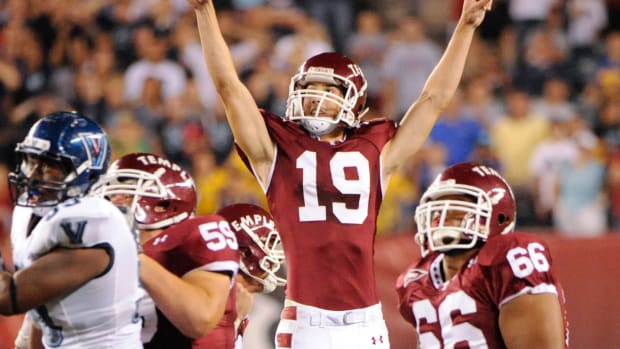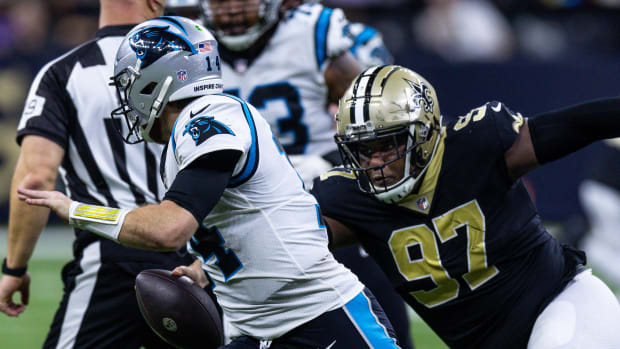Analytics Reveal why Broncos Fans Should Beware Alabama WR Henry Ruggs
When evaluating NFL Draft prospects, you're always looking for more tools to add to the process and improve the information on each guy. Outside of film, analytics are another important part of a very complicated pre-draft process that is replete with unpredictability.
When it comes a high-profile prospect like Alabama's Henry Ruggs III, or any wide receiver, one of those helpful analytics is called 'Breakout Age', which is a metric representing how old a prospect was in college when he posted a 'dominator' rating at or above 20. 'Dominator' rating represents the percentage of a team's yards, receptions, and touchdowns a single receiver produced in a single season.
History suggests that the earlier the 'breakout' year comes in college, the more likely the receiver is to be successful at the NFL level. Peter Howard of the Dynasty Football league did a lot of work to compile a database with over 600 receivers with all sorts of information. You can find Howard's Database here
Benjamin Solak of The Draft Network also published an article on this subject that inspired what you're reading now.
The question is, how should this information be applied to how the Denver Broncos are scouting the 2020 draft class? The Broncos are a team very much in the market for wide receiver help, which is why a player like Ruggs has become the most trendy selection in the ubiquitous fan mocks.
The Broncos are scouting wide receivers and this 'Breakout Age' metric would add another piece to the puzzle of trying to improve the odds of landing the right receiver(s) and avoid drafting another Cody Latimer or Carlos Henderson.
Again, this is highlighted in the Solak article, so make sure you give that a read. Let's start with the hit rates (from Solak’s article) in the NFL that reveals at what age different receivers had their breakout year in college. Here's a snippet.
Peter Howard of Dynasty League Football has a large database of WR prospects and their college market shares, dominator ratings and breakout ages. In 2018, he published hit rates for drafted WRs as a function of breakout age at a 20 percent dominator rating:
- 18-year-old breakouts: 38.5 percent
- 19-year-old breakouts: 31.3 percent
- 20-year-old breakouts: 20 percent
- 21-year-old breakouts: 8.9 percent
- 22-year-old breakouts: 16.3 percent
- 23-year-old breakouts: 14.3 percent
Trend-wise, it's clear: The earlier a wide receiver broke out in college play, the more likely he was to be successful at the NFL level. If a prospect didn't break out until late in his career, he wasn't nearly as likely to succeed in the NFL. Howard defined a hit for his hit rates as "a top-24 PPR season," which is a fantasy football paradigm that helps control for different eras of passing offenses.
Again in 2018, Anthony Amico defined a WR as a hit when he posted at least 200 PPR points within his first three seasons. Amico focused on top-100 picks and found hit rates for prospects based on their breakout age, using a 30 dominator rating cutoff:
- 18-19 years old: 46.2 percent
- 20 years old: 35.3 percent
- 21 years old: 19 percent
- 22 years old: 6.7 percent
With that said, before applying the info to Ruggs, I'm going to lay out 15 wideouts and their corresponding dominator rating and at what age each prospect was when he had that 'breakout' season. The analytics suggest that a higher dominator rating (over 20) at an earlier age is indicative of a higher chance of success in the NFL.
Applying the Metrics to 2020 Top WRs
CeeDee Lamb, Oklahoma: Posted a 25.6 dominator rating when he was 19 years old. He also posted a 35.4 when 20 years old.
Jerry Jeudy, Alabama: Posted a 25.9 dominator rating at 19 and 21.4 when 20 years old.
Laviska Shenault, Colorado: Posted a 32.7 dominator rating at just 19 years old.
Jalen Reagor, TCU: Posted a 22.7 dominator rating at 18 years old and then a 44.2 at 19 and 29.2 at 20.
K.J. Hamler, Penn State: Posted a 26.9 dominator rating at 19 years old and a 31.7 at 20.
Denzel Mims, Baylor: Posted a 33.1 at 19, 28.7 at 20 and 31.7 at 21.
Quartney Davis, Texas A&M: Posted a 23.3 dominator rating at 20 years old.
Justin Jefferson, LSU: Posted a 30.7 dominator rating at 19 years old and a 29.0 at 20.
Before getting to the next group of receivers, let us look at just these eight above, all of whom are in my top-11 receivers in the 2020 class. Based on the charts above, Jeudy has a 31.3% chance of success with the minimum dominator rating set at 20, but if we were to move it up to 30, he wouldn't qualify. With Davis, he also wouldn't qualify with is set to 30.
Lamb qualified for the 30 and would carry a 35.3% chance at being a hit since he hit it at 20. As for Jefferson, Hamler. Shenault, Reagor, and Mims, they all fall into the 46.2% having posted an above 30 dominator rating at just 19 years old.
Clemson's Tee Higgins isn’t being analyzed here, Ruggs will be mentioned later, and Arizona State's Brandon Aiyuk being a JUCO product doesn’t have a dominator rating for his younger years.)
The Next Group of WRs
The next set of receivers are USC's Michael Pittman, Michigan's Donovan Peoples-Jones, Nebraska's J.D. Spielman, Tennessee's Jauan Jennings, Kentucky's Lynn Bowden, and Minnesota's Tyler Johnson.
Pittman posted a 30.3 at 21 years old, which puts him in the 19% area for a dominator rating of 30 or higher. Looking at it with 20, he falls into the 20% having posted a 29.2 at 20 years old.
Peoples-Jones posted a 27.6 at 19 years old, putting him at 31.3%, but then didn’t break 20 any other year. For the minimum dominator rating of 30, he wouldn’t qualify.
Spielman was over 30 dominator rating at both 20 and 21 years old posting a 34.7 and 38.4 those years. This would put him in the 35.3% grouping for the 30 dominator rating minimum.
Jennings posted a 38.9 dominator rating, but did so at 22 years old. On the 30 scale, that gives him a 6.7% chance. He also posted a 21.9 at 19 years old, so for the 20 scale he would be at 31.3%.
At 20 years old, Bowden posted a 34.4 dominator rating, putting him in the 35.3% grouping as well.
Johnson put up some high dominator ratings coming in with a 61.3 at 19 years old, 51.5 at 20, and 38.1 at 21 years old. Since he first posted above 30 at 19, he would fall into the 46.2% grouping.
Ruggs an Inconvenient Outlier
All that leaves is Alabama's speedster, whom many Broncos fans are pining for. How does Ruggs measure up in Breakout Age and Dominator rating?
Ruggs never posted a dominator rating above 20. He came close at 19 years old with a 19.1 rating. When looking over the chart, there were over 100 receivers who never posted above a 20 dominator rating and only six of them stood out as having successful NFL careers. This number would be eight if we include Joshua Cribbs and Devin Hester, both of whom were more successful returners at the pro level rather than receivers.
The earliest one drafted was Vincent Jackson with the 61st overall pick. Terry McLaurin was the 76th overall pick and Tyreek Hill the 165th overall pick. Those were the only WRs to be drafted that saw success is the NFL who never posted a 20 dominator rating in college.
Wes Welker and Adam Humphries join the success, but both were undrafted. Adam Theilen was another undrafted find as well.
This doesn’t mean Ruggs III isn’t a good prospect and will bust in the NFL. There are outliers, and he may just fall into that category. However, there is a reason to be very cautious with drafting Ruggs III, especially in the first round. Remember, this is just another tool for the evaluation process.
The top-3 receivers on the Broncos' roster right now all posted above the 20 dominator mark in college, but only Courtland Sutton posted above the 30 mark. Sutton had a 40.1 at 19 years old, 42.4 at 20, and a 31.3 at 21.
DaeSean Hamilton posted a high of 26.7 at 22, but at 19 he posted a 22.5. Lastly is Tim Patrick who had a 29.3 at 22 years old.
This information doesn't make or break a prospect's draft stock. That cannot be overstated. All this does is provide some context, more information to the scouting report, and just another piece of the puzzle.
Follow Erick on Twitter @ErickTrickel and @MileHighHuddle.





